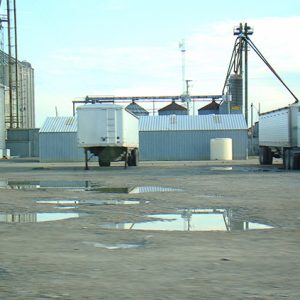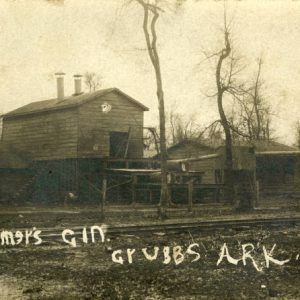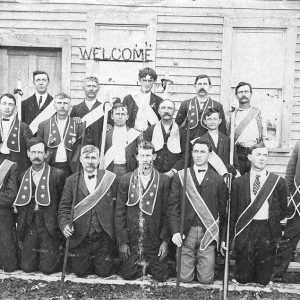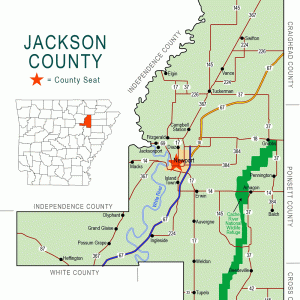calsfoundation@cals.org
Grubbs (Jackson County)
| Latitude and Longitude: | 35°38’59″N 091°04’26″W |
| Elevation: | 230 feet |
| Area: | 0.57 square miles (2020 Census) |
| Population: | 301 (2020 Census) |
| Incorporation Date: | January 15, 1909 |
Historical Population as per the U.S. Census:
| 1810 | 1820 | 1830 | 1840 | 1850 | 1860 | 1870 | 1880 | 1890 | 1900 |
| – | – | – | – | – | – | – | – | – | – |
| 1910 | 1920 | 1930 | 1940 | 1950 | 1960 | 1970 | 1980 | 1990 | 2000 |
| 178 | 300 | 366 | 345 | 313 | 360 | 442 | 546 | 528 | 438 |
| 2010 | 2020 | ||||||||
| 386 | 301 |
The city of Grubbs is in eastern Jackson County, near the Cache River. Founded as an agricultural center, the city—with the help of the railroad—became a lumber town for a time. In the twenty-first century, the focus of Grubbs is again agricultural.
A Church of Christ congregation was established in eastern Jackson County in 1877. The congregation was first known as Robinson’s Chapel. Citizens of the area appealed to the county government to create Grubbs Township, and the county did so in 1884. The name of the township and the developing community came from farmer and politician James C. Grubbs, whose home was used as the first voting precinct of the township. A post office, established in 1888, was also named for Grubbs. A school was also built around this time. A Baptist congregation was organized in 1898, meeting in the school building.
In 1905, a railroad was built into Jackson County from Jonesboro (Craighead County). Called the Bonnerville and Southwestern Railroad, it was intended to carry cotton and lumber, but it also offered passenger service. The line was quickly acquired by the St. Louis–San Francisco Railway (the “Frisco”). Because the line was more than a mile south of the settlement of Grubbs, a new community was platted along the railroad in 1906, and the citizens of Grubbs moved to the new location. The Morse Land and Timber Company built a large sawmill, which provided several hundred jobs to people living in the new settlement. Telephone service in Grubbs was established in 1908. Landowners filed for incorporation in 1909, the same year two banks were established in Grubbs. The first, a Farmers and Merchants Bank, was incorporated in June 1909 but evidently never functioned as a financial institution. In July, the Bank of Grubbs was incorporated, completing a bank building in 1910; the bank lasted nearly twenty years. A new school was built in Grubbs in 1912. It taught only through eighth grade until high school classes were added in the 1930s.
By 1912, Grubbs had a hotel, a blacksmith, two physicians, and eight stores, including a confectionery. A new Church of Christ building was completed in 1914, the same year the Baptist congregation also finished its new building. In 1917, a severe storm wiped out the Grubbs telephone system, which was not replaced until the following decade.
In January 1929, the Bank of Grubbs liquidated its holdings, announcing that “the bank had not been showing a sufficient profit to justify its operation in the small territory it had to serve.” A new school, constructed by the Works Progress Administration (WPA) was completed in 1938. A gymnasium was also built at this time by the WPA, but it was destroyed by fire in 1947. The high school burned to the ground in 1963, and both the high school and gym were replaced with new structures later that year.
With the mechanization of agriculture, the population of Grubbs and of eastern Jackson County experienced a steady decline. Consolidation closed the schools, and children from Grubbs attend the schools of the Jackson County School District, located in Swifton (Jackson County) and Tuckerman (Jackson County). Surviving businesses in Grubbs in the twenty-first century include a barber shop, a grocery store, a restaurant, and several agricultural businesses, including Overfield & Lloyd Irrigation and a Riceland Foods dryer. The population of Grubbs in 2010 was 386.
For additional information:
Gregory, Mildred Minor. “Early Days of Grubbs.” Stream of History 11 (July 1973): 3–12.
Grimes, Mrs. Grover. “Grubbs School—Past and Present.” Stream of History 21 (September 1984): 16–17.
“The Town of Grubbs.” Stream of History 4 (October 1966): 4.
Steven Teske
Butler Center for Arkansas Studies
 Grubbs Cotton Gin
Grubbs Cotton Gin  Grubbs Gin
Grubbs Gin  Grubbs Odd Fellows
Grubbs Odd Fellows  Jackson County Map
Jackson County Map 




(2014) I’ve lived here in Grubbs for fourteen years. This small town’s greatest fault has been a lack of “cleaning up the little town.” Just can’t seem to get a mayor and council who will put in the effort to get it done. Ordinances have been passed long ago, only to not be enforced. What could be a pretty, orderly, clean small city is pathetic looking. The main street looks like it’s been broke! It’s in an awful state of being. In cleaning up the town, there is an opportunity to do something which would add a positive note to this small city and to make Grubbs appealing to someone other than druggies. And the mayor/city council wouldn’t even do that.
I found this to be an interesting read, as I have called Grubbs home since 2007. My husband was born and raised here. We live in one of the oldest homes still standing, built in 1919. I actually have the original land deed and paperwork. I would, however, like to know more about my community and the home I live in.